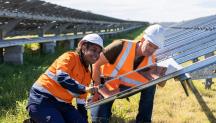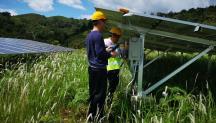

People Need to Experience a Tangible Benefit from the Energy Transition: Interview with an Expert
Newsletter
Key Facts
-
11 TW
Targeted global renewable power capacity by 2030
Interview with Michael Renner, IRENA Programme Officer, contributor to the joint IRENA—ILO report on renewable energy jobs
What are the main findings of the Renewable Energy and Jobs: Annual Review?
The number of people employed worldwide is continuing to grow. Looking at the past decade, jobs in the sector have risen from 7.3 million in 2012 to 12.7 million in 2021. So that is good news. There are several countries that stand out. China has the largest number of jobs, but other prominent countries include Brazil, India, the United States and collectively the members of the European Union. Most of the jobs in renewables are concentrated in these countries, but the report shows many other countries are raising their policy ambition and creating growing numbers of jobs. Mostly, these are jobs in construction and installations and in operations and maintenance. Countries are also attempting to build up a domestic supply chain and get a foothold in manufacturing and engineering because these sectors connect to other parts of the economy and offer a multiplier effect.
Why are these job figures so important?
Employment is always important, but in the energy sector, we need to demonstrate that moving away from fossil fuels to renewables and other alternatives makes sense not only from a climate and environmental point of view, but also from a socio-economic perspective. In other words, if people can be seen to gain a tangible benefit from this transition, then it will be much easier for them to accept it is the right path for the world to follow.
What makes renewable jobs so resilient?
If you look at the impact of COVID-19 in 2021 you do see that renewables fared better than the traditional energy industry. This partly reflects the fact that renewables are now often cheaper than fossil fuels, and partly because of a growing preference for clean energy. Many people would rather work in an industry supporting sustainability and offering a cleaner workplace than oil, gas or coal. But there is a long way to go, particularly outside the power sector. Looking at the transportation sector, as just one example, it remains heavily dominated by fossil fuel.
What should governments, corporations and other stakeholders involved in the renewable energy transition do to help people?
There need to be adequate and well-designed training and skilling programmes. People should be well educated, trained and experienced, so they can manufacture high-quality solar panels and wind turbines, and also ensure the delivery of high-quality installations. Beyond that, people need to feel there is a future for them in the energy transition. This means looking for ways in which people in the fossil fuels sector can be retrained, so they can use some of their expertise in renewable energy industries. We must help them make the switch. We also have to look at how communities and regions are affected. Do they attract renewables investment, or are they in danger of being left behind? There is a need to design policies for social protection, but also for regional revitalization, and to think about the transition in a holistic manner. The more that energy transition policymaking ensures that all stakeholders have been consulted, the more successful it will be in generating widespread acceptance and support.
Read the latest report on Renewable Energy and Jobs here.




